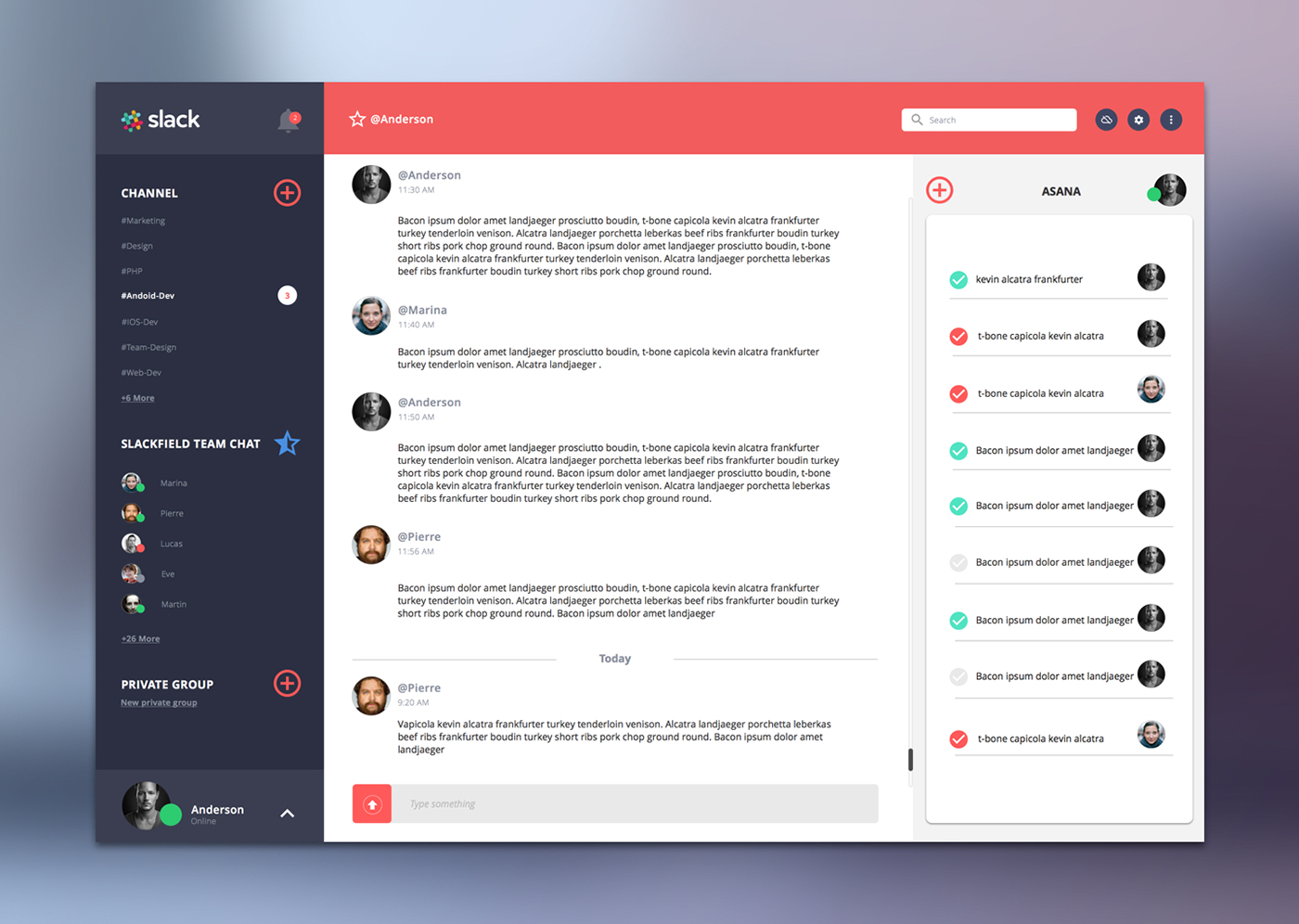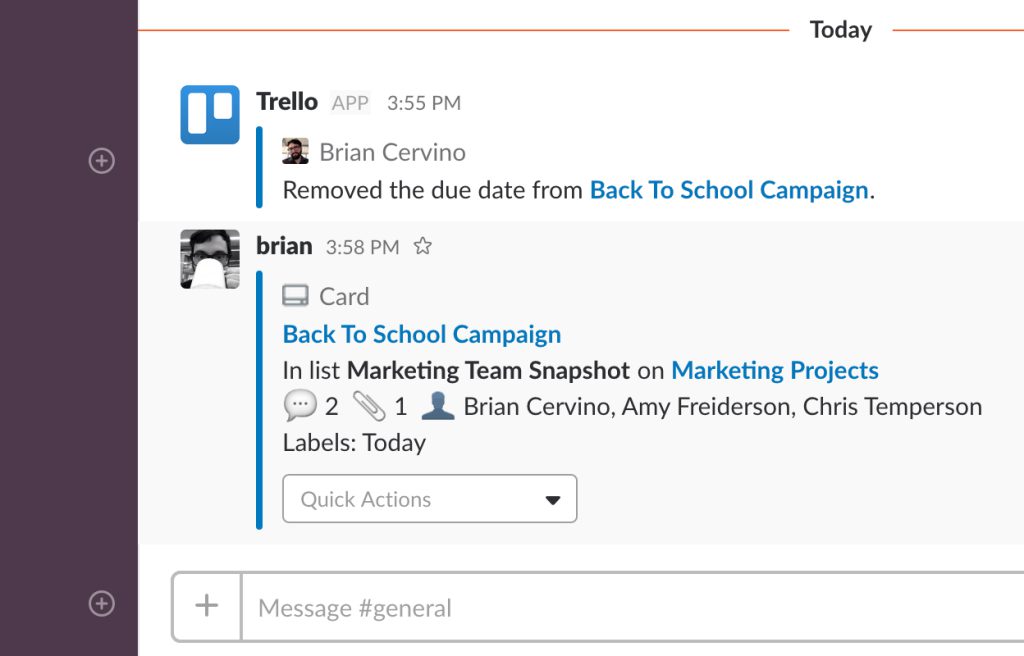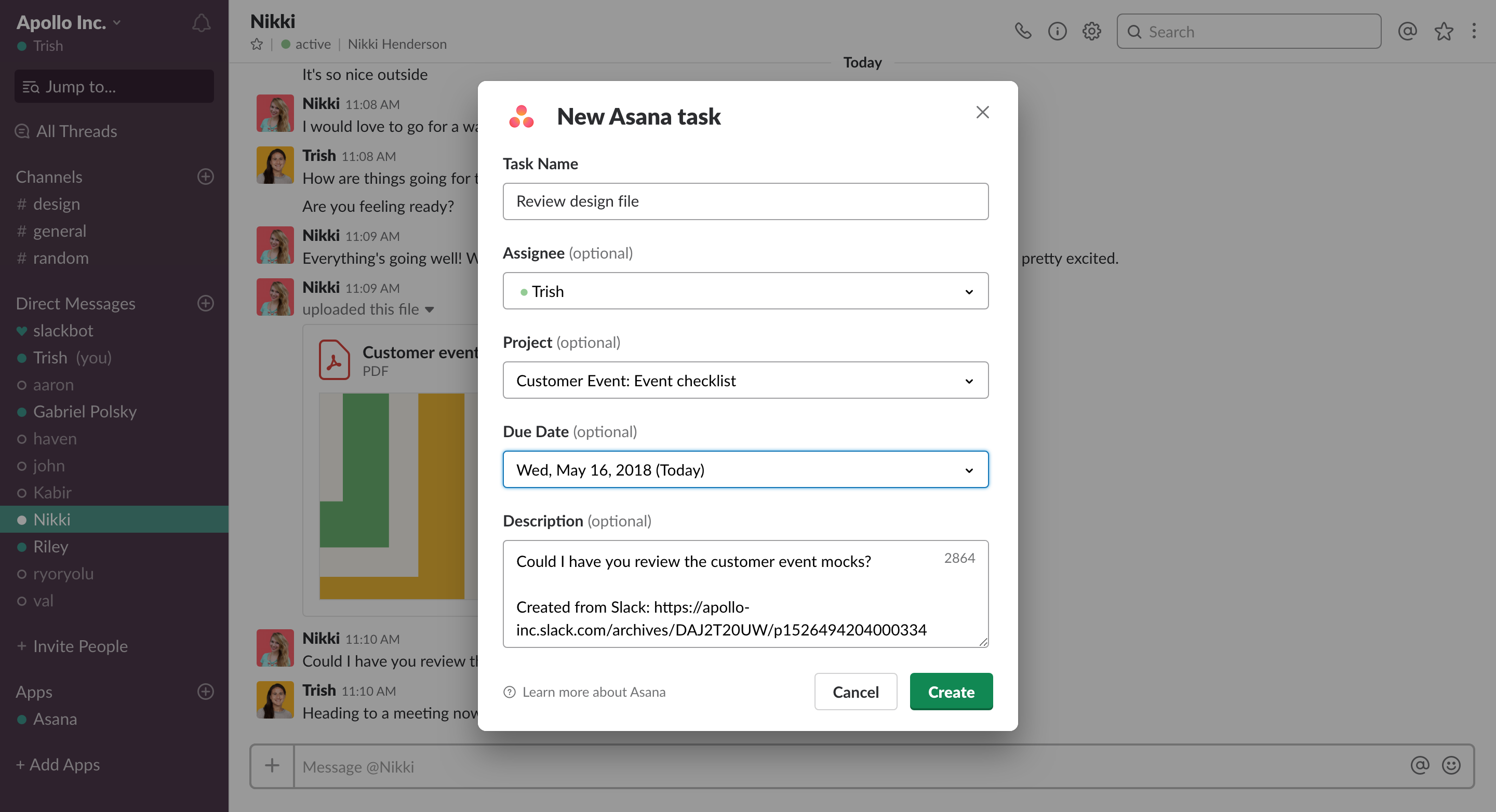Once this is completed, the new Asana for Slack replaces its old version. Integrating Slack to Basecamp.
- Connect your everyday Atlassian tools to Slack. Quickly resolve Jira issues, streamline tasks tracked in Trello, comment on Confluence pages, and more.
- Asana for Slack With the Asana app for Slack, you can manage work more efficiently and make discussions in Slack actionable. Link projects to channels, create new tasks from messages in your workspace and get notified of important Asana project updates – all without leaving Slack. Install the Asana app to Slack.
- Slack is great for chatting and quick updates and Asana is our go-to for collaboration and action items. Now, when casual chatter in Slack turns into an action item, it’s easily transferred to our home base, Asana. This new integration will ensure our team follows through on ideas and everyone knows where work stands.


Howdy Everyone,
So I keep seeing a lot of comments in this community about using slack in Asana and I’m getting confused as to why people use Slack instead of just the regular chat boxes and conversation tools already in the software? Could any business people here maybe hit me with some pro’s and con’s of why I should consider using Slack? Doesnt’ this defeat the purpose of having everything centralized/in one place? The fact so many people is giving me fomo!
Can someone drop some knowledge bombs on me as the advantages of using Slack instead of the default Asana communication tools?
Yours In Silicon Valley Awesomeness,
Sam
When Tonya Parker, a mom in Illinois, wanted to better organize her family life a little over a year ago, the first thing she did was set her kids up on Trello, a web-based project-management tool. Parker’s four children, ages 9 to 18, now use Trello, which is more typically used at work, to keep up with chores, to-do lists, shopping, and homework. “I use it every day to keep track of what schoolwork I need to do, or places I need to be, things to buy,” Hannah, her 15-year-old daughter, says.
“College was my first experience of having to keep track of my own stuff,” Tonya said. “I wanted [my kids] to have that sooner.” Incorporating Trello, along with Gmail, into the Parker family’s life has been a godsend, in Tonya’s view. It streamlined family communication, helped keep everyone organized, and added a layer of accountability to tasks. Now, instead of wondering if her children forgot to do something, Parker says she can ask, “How are you doing on your checklist?”
Children’s free-play time has been on the decline for more than 50 years, and their participation in extracurricular activities has led to more schedule-juggling for parents. Parents are busier too, especially those whose jobs demand ever more attention after hours: 65 percent of parents with a college degree have trouble balancing work and family, a 2015 Pew Research Center report found, compared with about half of those without a college degree. In an effort to cope, some families are turning to software designed for offices. Parents are finding project-management platforms such as Trello, Asana, and Jira, in addition to Slack, a workplace communication tool (its slogan is “Where work happens”), particularly useful in their personal lives. In other words, confronted with relentless busyness, some modern households are starting to run more like offices.
More in this series
The Underlying Messages That Screen-Time Recommendations Send Parents
Joe PinskerWhen Kids Realize Their Whole Life Is Already Online
Taylor Lorenz
Julie Berkun Fajgenbaum, a mom of three children ages 8 to 12, uses Google Calendar to manage her children’s time and Jira to keep track of home projects. Ryan Florence, a dad in Seattle, set up a family Slack account for his immediate and extended family to communicate more easily. And Melanie Platte, a mom in Utah, says Trello has transformed her family life. After using it at work, she implemented it at home in 2016. “We do family meetings every Sunday where we review goals for the week, our to-do list, and activities coming up,” she says. “I track notes for the meeting [in Trello]. I have different sections, goals for the week, a to-do list.” Her oldest son started high school last year, and Platte says that without productivity and task-management software, she doesn’t know how he could manage it all. Trello allows her son to track responsibilities and deadlines, and set incremental goals.
Emily Oster, an economist at Brown University and the author of Cribsheet: A sizes-at-0=' targeting-pos='boxrr2' targeting-native='standard' sizes-at-976='rail,native'>
“We think of Trello as a tool you can use across work and life,” says Stella Garber, the company’s head of marketing. “The example we had on our homepage for a long time was a kitchen remodel. On our mobile app the example was a Hawaiian vacation. We know humans have a lot of things they need organized, not just what they have at work.' (Slack declined to share any information about how people use its software, and Atlassian, which owns Jira, did not respond to a similar request.)

Asana For Slack Music

Despite these tools’ utility in home life, it’s work where most people first become comfortable with them. “The membrane that divides work and family life is more porous than it’s ever been before,” says Bruce Feiler, a dad and the author of The Secrets of Happy Families. “So it makes total sense that these systems built for team building, problem solving, productivity, and communication that were invented in the workplace are migrating to the family space.”
Melissa Mazmanian, an informatics professor at UC Irvine, agrees. “The way that we imagine knowledge work and more and more kinds of work is really about coordination and collaboration across distance, across people’s different time commitments, managing attention, figuring out who’s going to do what when,” she says. “And that style of work … It’s very similar to family life, if you think about it.” Perhaps one’s children and direct reports are not so different after all.
Asana Software
Mazmanian says that these programs might be of particular value to households with two working parents, an arrangement that more children grow up with now, compared with a few decades ago. Without one adult in charge of the professional domain and one in charge of the domestic domain, there’s more coordination of who’s in charge of what—which is something productivity tools can assist with.
She wonders whether a program like Asana might help even out the imbalances in household duties that often arise between partners—especially men and women—by making them more visible. “It tends to be that couples divide this work up in ways that aren’t exactly equitable, and that one person takes on more of that truly invisible work … Something like this might actually be a way for that person to say, ‘Look what I’m doing’ [to their] family [or] partner.”
Perhaps the desire to streamline home life is also a product of how much employers ask of today’s knowledge workers. “I see the use of business software within households as an effort to cope with feeling too stretched at work,” says Erin Kelly, a professor at MIT’s Sloan School of Management and a co-author of the forthcoming book Overload: How Good Jobs Went Bad and What We Can Do About It. She says that the “escalating demands” of many white-collar jobs leave workers (parents or not) increasingly frazzled and worn out—so the same tools that systematize their workdays might appeal as a way to cut down on the time they spend organizing life at home.
This strategy doesn’t always play out smoothly, though. For Peder Fjällström, using Slack at home was mainly a fun experiment. A former app designer who lives in Stockholm and is starting a kombucha brand, Fjällström, initially was excited about using the software at home a couple of years after adopting it at work: He custom-built little tools within the program that would let members of his family add an item to the grocery list when something was running low, report “bugs” in the house (like a broken appliance), and determine the kids’ current location (pulled from the Find My iPhone app). On occasion, Slack was also a way for Fjällström and his wife to summon their two kids at dinnertime.
Asana For Slack Video

Asana Slack Channel
But the Slack experiment lasted only three or four months—the kids soon gravitated toward apps that were “more fun.” After some reflection, Fjällström has concluded that using Slack with his family made home life feel more like work. “It helped at that point in time because it felt like life was a bit messy … but life is supposed to be a little bit messy.” There are things, he recognizes, that productivity software doesn’t optimize for, such as carving out quality family time and allowing children to “feel all the emotions.” “That’s what we’re aiming for at the moment,” he said, “not structure.”
